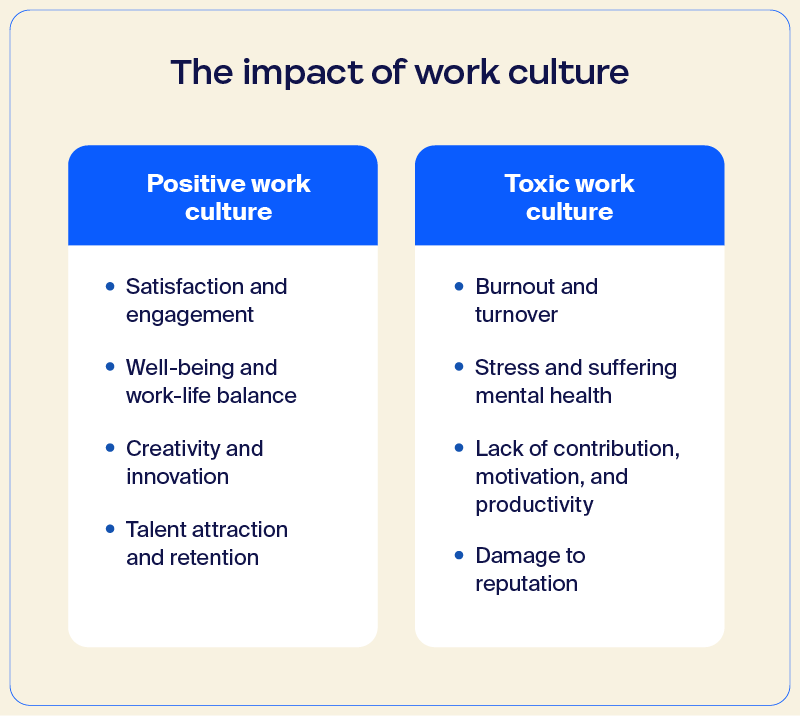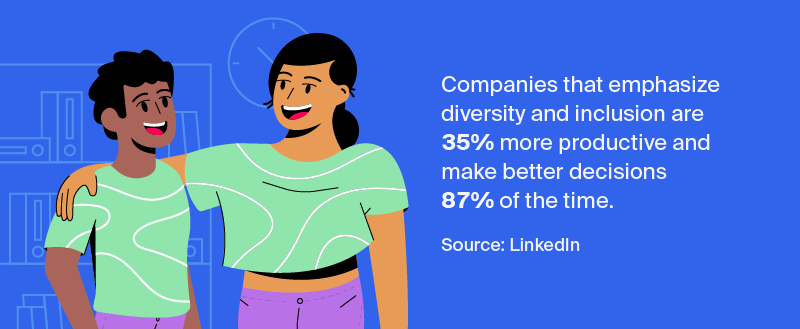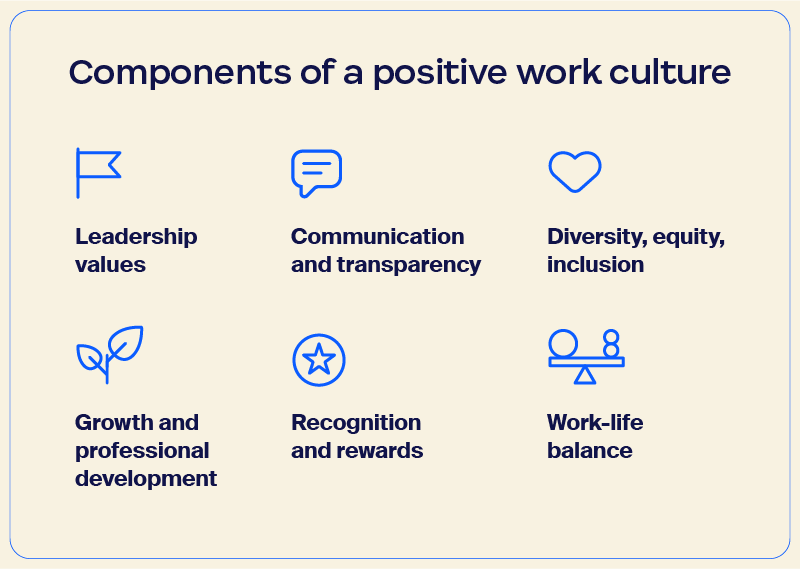
Meet Zoom AI Companion, your new AI assistant!
Boost productivity and team collaboration with Zoom AI Companion, available at no additional cost with eligible paid Zoom plans.
Updated on October 02, 2025
Published on October 02, 2025


Whether we operate in a remote, flexible, or in-office model, work culture impacts everything we do. The effect work culture has on the workplace can be positive or negative, depending on leadership decisions, employee engagement, and other factors.
Understandably, work culture has become more difficult to determine in our increasingly digital world. Flexible work models — new territory for many companies — demand that we redefine what work culture looks like, how it functions, and how to maintain it.
Collaboration platforms play a major role in fostering the right work environment. We’ll get into that shortly, but first, let’s dive into how work culture is built, how it differs between the office and flexible work models, and the elements you’ll need to focus on as you level up your own.
Work culture is a culmination of a company's values, beliefs, attitudes, and particular behaviors. It’s meant to be both a guideline for internal and external interaction as well as a sense of the company’s personality — its collective identity and “way of doing things.”
Work culture isn’t a collection of free lunches, gift card rewards, awkward selfies, and coupon contests. It’s less about activities, rewards, and games and more about how your shared values impact your working environment. These things can be a reflection of a culture that values employee recognition, but should never be the entirety of it.
You can tell a lot about a company’s work culture from its mission, vision, leadership style, communication practices, and employee satisfaction. Needless to say, work culture can range from positive to toxic depending on where these aspects fall.
And this isn’t a one-size-fits-all concept. For example, a tech company that values pioneering innovation may structure its work culture around risk-taking and experimentation like company-wide hackathons. However, a company that focuses on customer service may find empathy and responsiveness more fitting for its industry by supporting employees and creating open communication channels where it’s easy to ask for help.
The state of your work culture can affect your company’s success and your team’s well-being. A positive work culture can boost productivity and motivation and increase employee satisfaction. A toxic work culture, on the other hand, can boost turnover rates and employee burnout and create a negative impression of the brand.

A positive work culture is the result of carefully considered values and processes. Here’s how those little details come together to change your business:
The other side of the coin is something many companies just fall into — it’s often an unintentional spiral caused by poor leadership decisions, lack of awareness, or the wrong approach to team management.
When leadership emphasizes short-term results or prioritizes work over flexibility and balance, it can breed a toxic work culture that festers over time. The impact is as negative as one can expect.
A positive work culture stems from the company’s identity, which is rooted in both action and words. A company that claims to care about internal communication, collaboration, and innovation needs to operate by those values or risk cultivating a toxic environment. Here are the components you should consider.
Your leadership values are the foundation of everything that happens at your organization. Confirm everyone is aligned on a list of core values that reflect your company’s current and long-term strategies.
For example, Apple’s Shared Values page showcases its leadership values and provides employee stories that pertain to each value. In each example, Apple demonstrates its commitment to these values, from employee well-being to supporting creativity, diversity, and eco-friendly practices.
When done right, communication between the team and its leadership fosters trust as well as an open and honest basis for conversations. Employees feel informed, valued, and kept in the loop. When people feel trusted, it creates a sense of belonging, which helps create a cohesive and supportive work environment.
For example, Buffer cultivates a culture based on transparency and open communication. The company publicly shares details such as salaries, investments, time off, and even books the team is currently reading.
Supporting diversity, equity, and inclusion (DEI) goes beyond creating a positive work culture — it can empower teams to contribute to the company’s vision and give way to creativity that’s otherwise unachievable in a homogenous environment. Supporting DEI often unearths exceptional talent and promotes a sense of equality and positive thinking.
Businesses looking to foster this kind of culture should apply these values internally through diverse hiring and promotion practices, inclusive policies, and a commitment to constant improvement.
For example, Salesforce is globally known for its commitment to diversity and inclusion, going so far as to promote that commitment in the wider tech sphere by putting forward initiatives such as the Equality Awards, in which they recognize and praise individuals and companies who show a similar dedication to this cause. Through leadership development programs and community engagement efforts, Salesforce creates a work culture that values diversity within its organization and beyond.

Employees who feel stuck in their careers start looking elsewhere for opportunities to grow professionally. That’s why it’s important for businesses to nurture a professional growth path that allows employees to move forward in terms of learning, responsibility, pay, and future contributions. Businesses that do this right often develop training programs to help team members feel supported and empowered to improve and climb the ranks.
For instance, filling an open position by bringing in new hires rather than promoting internally can cause a rift between aspiring employees and their leadership. To do this right, leaders can outline career paths and growth opportunities so employees are clear on their progression. You can also empower your employees to take on new responsibilities and tackle tasks outside the scope of their role — tasks that speak to their professional growth interests.
For example, Google is known for its commitment to employee development. Its “20% time” policy allows employees to set aside a portion of their workweek for projects outside their role’s core responsibilities. The culture is rooted in continuous learning and development, which not only encourages team members to be innovative but to also pursue their interests and work on new skills.
When we say “rewards,” we’re not referring to gift card contests that HR sometimes hosts at the office. Recognition can be delivered in any format, whether through your collaboration software of choice or during in-person meetings. It’s important for employees to feel recognized, acknowledged, and supported. This often boosts their confidence, performance, and satisfaction, leading to a healthier and more productive workforce.
Consider a work culture where recognition is the norm by highlighting achievements and recognizing admirable behaviors. Reward good work by shining a light on it during team meetings, all-hands video conferences, and team chat channels on your collaboration software.
For example, Disney Institute emphasizes that recognition should be integral to company culture. Leaders highlight how small, personalized acts of recognition boost morale and engagement. Whether through peer-to-peer acknowledgment or simple gestures, these make all the difference to employees. Disney’s approach shows that recognition fosters stronger relationships, drives productivity, and reinforces positive behaviors.
Work-life balance is now one of the most important aspects of work for employees. Companies that provide employees with more flexibility attract and retain more talent than businesses that don’t. A survey conducted by Deloitte revealed that the majority of Gen Z and millennials on a remote or hybrid model would look for an entirely new job if they were asked to work from the office full-time.
Giving employees the power to recharge, spend time with loved ones, and pursue personal interests outside of work shapes happier and more fulfilled employees. That’s why generous PTO policies, flexible work models, paid parental leave, and sabbaticals boost productivity and retention rates.
For example, Patagonia prioritizes work-life balance by offering generous paid time off, wellness days, and paid parental leave to support employees' well-being. Their on-site childcare and travel support for parents with young children ensure that employees can balance family and work responsibilities. They also provide paid activism hours, allowing employees to engage with causes they care about while maintaining a healthy work-life integration.

Positive work culture isn’t one-size-fits-all. You should work toward creating a company culture that reflects your company’s mission, values, and employees. If you don’t intentionally decide on a type of work culture, employees will naturally create their own, and it may not be a positive one if negative behaviors and attitudes are allowed.
Define what a good culture means for your team and use this to build your daily operations. You should also consider factors like the layout of the office (if you operate in-person), how often the employees interact with leadership, and the personality of the workforce. Once you have that foundation, design concrete policies and practices to reinforce that culture.
For example, here at Zoom, we foster success through a strong culture built around our core value of care. Employees are encouraged to care for our customers, teammates, community, and ourselves, aided by strategic programs that allow us to do so. Zoom Cares, our philanthropic arm, supports community-centered giving and encourages employees to donate to causes that matter to them with company-matched funds. Our peer recognition program allows employees to recognize teammates who go above and beyond with shoutouts and gifts.
Provide each department with tangible goals and results to work toward to help employees emulate the company culture. This can help guide their performance and also lead to collaboration. When you’re beginning to implement your culture, make sure you allow room for feedback and can adjust the KPIs if needed.
For example, Scooter’s Coffee effectively implemented structured goal-setting to enhance employee engagement and performance. The company established clear individual and team objectives, leading to an 81% adoption rate of employee goals. This approach facilitated regular feedback, recognition, and alignment with organizational targets, contributing to a nearly 5% reduction in employee turnover and a significant increase in internal promotions.
Creativity thrives when people feel that they can think outside the box and not be punished or fired if the experiment doesn’t work. Building a positive workplace culture means allowing teams to share fresh ideas without worrying about being judged or rejected. It’s not just good for morale; it’s actually a smart business move.
For example, Snap Inc. fosters creativity by having new employees pitch an idea on their first day without any preparation. Their goal from this exercise is to initially remove the fear of failure and foster a culture where experimentation is the norm. The culture encourages quick thinking, confidence, and innovation. By setting this tone from day one, Snapchat signals that fresh perspectives and taking risks are expected and accepted, empowering everyone, regardless of their leadership status, to bring their ideas forward and continue innovating.
Create a zero-tolerance policy work culture, which defines unacceptable behaviors such as harassment, discrimination, or retaliation and outlines immediate consequences for violations. Adopting this policy helps foster a culture of accountability, safety, and respect where employees feel protected and valued.
For example, Oregon Health and Science University (OHSU) created a formal Zero Tolerance and Accountability Policy to protect both staff and patients. The policy outlines steps for employees to report misconduct and emphasizes this through their leadership practices. The organization also trains employees to fully understand their rights and the consequences of any violations to reinforce a zero-tolerance work culture. OHSU’s leadership team regularly reviews and updates the policy to ensure it stays effective and relevant to signal to employees that safety and respect are non-negotiable at their workplace.
Every employee, whether they’re an intern or a C-level manager, should know that their opinions matter and will be considered. Good ideas and feedback can come from anywhere, and employees are more willing to share their input if they know it will actually be taken seriously.
For example, Sogolytics, a company specializing in employee engagement and feedback, understands the profound impact of feedback on company culture and ROI. They use employee retention as the bedrock of a healthy culture that fuels their revenue because they believe that the employee’s journey in the company plays a pivotal role in determining employee satisfaction levels. To support this type of culture, Sogolytics provides tools that help leaders gather feedback on the employee lifecycle, to ensure there is continuous listening and collect data that can make tangible improvements to the culture.
A good culture in the workplace allows for flexibility in employees’ lives outside of work. Emergencies may arise, and people still have responsibilities to take care of. Flexible schedules and time-off policies can allow employees to show up as their best selves at work.
For example, Athenahealth is an excellent example of a modern, inclusive, flexible work opportunity. It’s offering more roles with flexible hours, and a work-life balance that is conducive to the employee’s lifestyle as part of the company values. For most positions in the company, you can even work remotely. If you can’t work remotely, those positions have a flexible in-office and at-home schedule. This flexibility not only supports employee well-being, but also increases productivity and engagement by allowing people to work in the ways that fit their needs the best.
A toxic work culture builds up over time through poor communication, lack of accountability, and eroded trust. You can avoid this type of work culture by taking some proactive steps.
While the eight-hour day is the norm, not every employee can focus for eight hours straight. Encourage employees to take regular breaks, recharge, and avoid glorifying after-hours work. Promoting a culture that values balance over burnout can improve long-term productivity and morale.
Learning and growth opportunities aren’t just great for helping your employees; they can also uplevel your company. Set up lunch-and-learns where team members can share expertise and pair newer employees with mentors for skill-building and career guidance
Bad managers can quickly lead to toxic workplaces and become one of the main reasons your best employees will seek other opportunities. In fact, 84% of workers have identified bad managers as their source of unnecessary stress, according to a SHRM survey. To prevent this, invest in regular leadership training, provide new managers with mentorship, and create channels for feedback.
While life happens and problems can arise, your work culture should encourage everyone to honor scheduled one-on-one time. Keeping that meeting whenever possible shows respect and value for that person’s time and makes both parties feel heard and respected.
Trying too hard to make a work culture happen can actually lead to the opposite outcome. Creating a company culture doesn’t happen overnight — it will start to take on a life of its own organically, so be consistent and stay the course.
Strong collaboration is the backbone of a thriving work culture, whether your team is in-office, remote, or hybrid. The right tools can streamline and encourage knowledge sharing and build trust across departments to develop your ideal work culture.
Zoom Workplace brings meetings, chat, whiteboard, and scheduling together in one place — perfect for companies that want to invest in a people-first workplace culture. Our employee engagement platform, Workvivo, can help you communicate with and celebrate your employees with a seamless experience in the Zoom Workplace app.
Learn more about how Zoom Workplace and Workvivo can support your team’s culture.